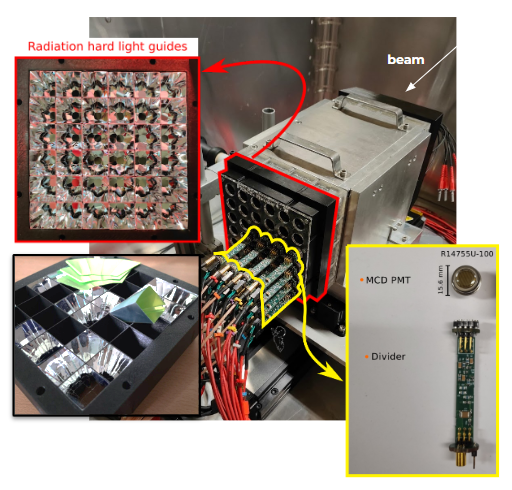Prototype profile: Switch Support for High Pressure valves

CMS and ATLAS have several cooling systems underground and on the surface with manifolds that need to be operated manually. In these manifolds, there are several high-pressure valves which are purely mechanical parts.
The aim of the switch support is to be able to install on each valve a simple switch in order to allow the monitorisation of the valve position from a SCADA platform without the need to be on-site.
Prototype profile: Light guide development for the electromagnetic calorimeter upgrade of the LHCb experiment

Kacper Jama and his team are focusing on the development of prototypes for the electromagnetic calorimeter (ECAL) upgrade of the LHCb experiment. For this project, many parts have been made in different laboratories, and some of them have been made here at ldeaSquare, such as the Light Guide (LG).
Re-designing a battery recollection container for CERN: when IdeaSquare alumni help with the laboratory recycling challenges
A team made up of former students of IdeaSquare worked on a surprising challenge: re-designing a battery recollection container for CERN. The project recently completed the prototype validation phase and is entering production.
 A team made up of former students of IdeaSquare worked on a surprising challenge: re-designing a battery recollection container for CERN. The project recently completed the prototype validation phase and is entering production.
A team made up of former students of IdeaSquare worked on a surprising challenge: re-designing a battery recollection container for CERN. The project recently completed the prototype validation phase and is entering production.
Prototype profile: LHC Vlead Tester Box

The box, called "LHC Vlead Tester", will be used to test power converters which supply current to superconducting magnets.
Because superconducting magnets are cooled to cryogenic temperatures there is a device called "current lead" that enables the connection of room-temperature conductors to cryogenic conductors. These current leads are critical devices, therefore the voltage across them is monitored by the power converter which will shut down if a certain voltage threshold is reached.
Prototype profile: Design and validation of a safe mechatronic system for the handling of radioactive sources

The LHC tunnel is a highly radioactive environment during the operation of the machine.
Four thousand Beam Loss Monitors (BLMs) are placed along the magnets to ensure no radiation escape. It is essential to verify the proper operation of each of these BLMs before operation to ensure safety.
Prototype profile: 3D printed base for Cryogenics CHARM radiation campaign

The latest TE-CRG-IC radiation campaign took place during August-September 2023, in CHARM (CERN High energy AcceleRator Mixed field/facility).
Automated tests were running for three weeks, every three hours, sending and receiving signals from the radiated components.
Prototype profile: Affordable and customisable remote-controlled microscope

Digital microscopes are often a useful tool to have in a laboratory.
However, commercially available microscopes are usually either cheap and low quality, or extremely expensive.
The present prototype was designed to provide a middle-ground, offering a remotely controlled microscope of decent quality, at a price well below 500 CHF.
A custom board hosts the drivers and the microcontroller that controls the movement (up to 4 axes). A Raspberry Pi high-quality camera, readout using a Raspberry Pi 4 hosts the web interface and takes care of the image processing.
Prototyping profile: Calibration setup for gamma-ray detectors

This setup measures the propagation-angle of gamma-rays from a radioactive source. Mounted on a movable X/Y table, it will be used for the calibration and characterisation of Terapet's gamma-detectors.
The part has been designed from relatively thick laser-cut acrylic sheets. This construction provides better accuracy and robustness compared to a previous design printed from PLA.
Prototype by Michael Betz (Terapet detector development)
Prototyping profile: Alignment mechanism for ATLAS/CMS

Installed inside the shielding of two of the largest experiments at the Large Hadron Collider, ATLAS and CMS there are special collimators known as the Target Absorbers (TAS).
This equipment needs to be adjusted manually each time the detector opens. In addition to this, the TAS has been modified over the years, meaning that the alignment procedure does not match the procedure that was originally envisaged.
Pagination
- Previous page
- Page 2
- Next page
